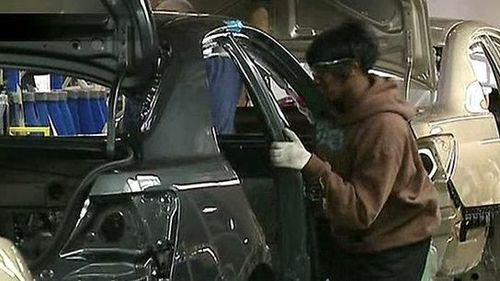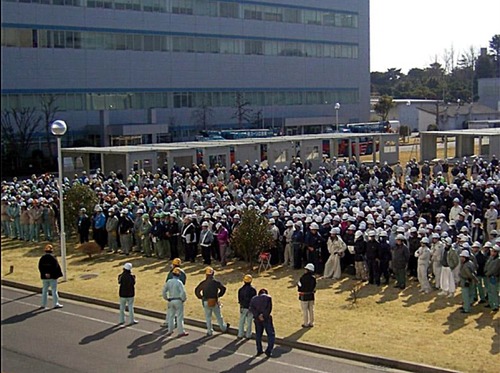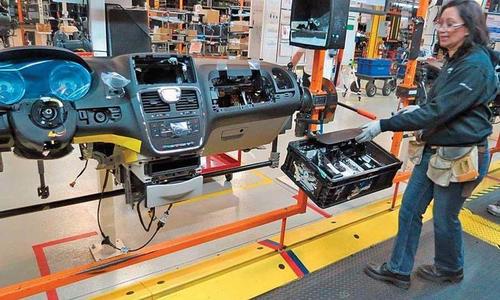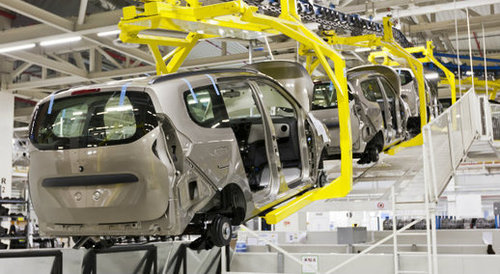Sep 1 2013
‘Lean’ Manufacturing Takes Root in U.S. | Fox News
See on Scoop.it – lean manufacturing

This article in from April 29, 2011, but I just found it today. The facts are approximate, as you would expect from Fox News, but the video includes a good segment on a raku-raku seat in action and an interview of Jeffrey Liker.
 The article presents the Toyota Production System are being strictly make-to-order, which makes you wonder where the new Toyotas for sale at your local dealership come from.
The article presents the Toyota Production System are being strictly make-to-order, which makes you wonder where the new Toyotas for sale at your local dealership come from.
Toyota’s system is also presented as centered on collocating designers, suppliers, sales and marketing by project, which says nothing about production… Incidentally, no one who has actually researched Toyota’s approach to product development describes it as collocating everybody.
Even the Liker quote about Toyota’s not having laid off anybody during the financial crisis, while formally accurate, does not take into account what happened with temporary workers. These workers do not have the tenured status of permanent employees, but some work for the company continuously for years.
See on www.foxnews.com












Sep 13 2013
A defense of old-fashioned WIP accumulation | Manufacturing Digital
See on Scoop.it – lean manufacturing
 “Toyota pioneered modern lean manufacturing and created a highly efficient and reliable manufacturing system that the rest of the world sought to adopt with huge variations in success. A main thrust of Lean philosophy is to closely examine manufacturing processes, find unnecessary steps and eliminate them. The same philosophy suggests that we should only allow room for value adding steps – in terms of value perceived by the customer – as this drives up efficiency and enables us to manufacture simpler and faster. It is said that accumulating work-in-progress through the process ties-up resources and can obscure problems and is therefore deemed to not add value, so conventional Lean thinking is to eliminate this wasteful step.With this thinking comes a generally held view that Lean manufacturing and Accumulation cannot coexist…”
“Toyota pioneered modern lean manufacturing and created a highly efficient and reliable manufacturing system that the rest of the world sought to adopt with huge variations in success. A main thrust of Lean philosophy is to closely examine manufacturing processes, find unnecessary steps and eliminate them. The same philosophy suggests that we should only allow room for value adding steps – in terms of value perceived by the customer – as this drives up efficiency and enables us to manufacture simpler and faster. It is said that accumulating work-in-progress through the process ties-up resources and can obscure problems and is therefore deemed to not add value, so conventional Lean thinking is to eliminate this wasteful step.With this thinking comes a generally held view that Lean manufacturing and Accumulation cannot coexist…”
The gist of this article is that you should hold just enough WIP to meet your production requirements with the changeover times you currently have and protect your bottlenecks against malfunction in other resources. So far, this is stating the obvious, and a visit to a Toyota plant or even dealership is enough to see that the Toyota system is not one with zero inventory. You see shelves of stampings, bins of bolts, and trees of wire harnesses. The Kanban system involves some inventory, and, in fact, the only approach that doesn’t is just-in-sequence. What is considered waste is not all inventory, but unnecessary inventory, accumulated for no valid reason anyone can explain.
The article, however, goes further and asserts that it is cheaper to accumulate WIP than to expose and solve the problems that make it necessary, which is a return to the mass-production thinking that was prevalent in pre-Lean operations management.
What the Lean successes of the past decades have shown is (1) that the overall costs of WIP were understated and (2) that the ingenuity of production people and engineer was underestimated. You operate today and next week with the resources that you have, dysfunctional as they may be, and you hold WIP as needed to sustain production. As you do this, however, as an organization, you keep working at solving your problems so that you need less and less WIP month by month and quarter by quarter. This perspective is missing from the article.
See on www.manufacturingdigital.com
Share this:
Like this:
By Michel Baudin • Press clippings 0 • Tags: Lean, Mass Production, Toyota, TPS, WIP